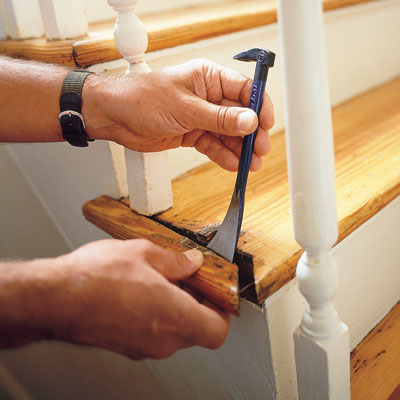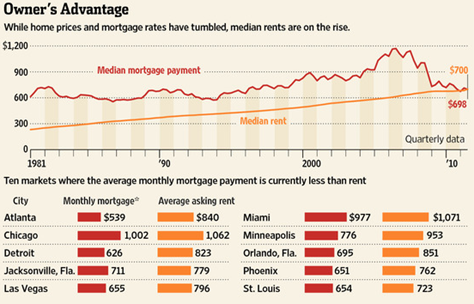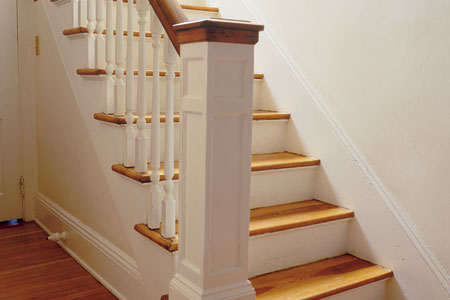Archives for 2011
Steve Jobs: Crazy Ones
What Saving Money Looks Like Over Time
Reversible Interior Shelf Fits Both Inside & Outside Corners

Versatility meets simplicity in this dual-mode shelving object constructed quite simply from two-by-fours and requiring little more than a chop saw (for 45- and 90-degree cuts) and a hammer to build, for the DIY-inclined.

Titled Kulma (the Finnish word for corner), this piece was designed by Martina Carpelan, whose “goal as a designer is to bring function, esthetics and timelessness together, “reflecting her “great interest in observing the everyday, her surroundings and behavior.”
Jobs Report Bodes Well for Housing
 The November jobs report was good news for the economy and even better for housing: unemployment among 25-34 year-olds fell to 9.2%, and quarterly job growth in “clobbered cities” was strong at 1.9% (annualized rate). However, construction employment slipped.
The November jobs report was good news for the economy and even better for housing: unemployment among 25-34 year-olds fell to 9.2%, and quarterly job growth in “clobbered cities” was strong at 1.9% (annualized rate). However, construction employment slipped.
Economic recovery is essential for housing demand to pick up. But three indicators in the monthly jobs report tell us whether the recovery in housing demand is underway, approaching or still far off. These include:
- Construction job growth
- Unemployment among 25-34 year-olds
- Job growth in cities clobbered by the housing bust
Construction job growth
Construction jobs are at the heart of the virtuous or vicious cycle that connects jobs and housing. Housing demand leads to more jobs in construction and related industries, and more jobs means more income and housing demand.
In November, construction employment fell month-over-month and grew just 0.3% versus 3 months ago, compared with total employment growth of 1.3% (seasonally adjusted annualized rates). Total employment is up 1.9% from its recession low, but construction employment is up just 0.8% from its bottom in January 2011 (cumulative rates). Construction employment still has a lot of catching up to do to get back even to its pre-boom share of overall jobs.
Unemployment among 25-34 year-olds
Between the ages of 25 and 34 is prime time when many people form households with a spouse, partner, roommate, or by themselves, then start families and buy their first home. During and after the recession, household formation dropped for this age group, and more of them than ever are living with parents or other adults rather than renting or owning their own place. These folks will wait to form their own households and consider homeownership only when their job prospects improve. A key measure for housing demand and homeownership is the unemployment rate for this group and the share of this age group that is employed.
In November, the unemployment rate for 25-34 year-olds dropped sharply to 9.2% from 9.8% in October and is at its lowest level since early 2009 (except for a one-month dip this March). The unemployment rate for all adults also dropped, from 9.0% to 8.6%. In November, 73.9% of 25-34 year-olds were employed (the rest are unemployed or not in the labor force because they’re in school, discouraged from looking, or not looking for other reasons), up from lower September and October levels, so the unemployment drop is not primarily due to young adults leaving the labor force.
But the job market remains tough for this key age group: before the recession, unemployment for 25-34 year-olds followed the overall rate pretty much exactly, but has remained stubbornly above the all-adults rate even as the unemployment rate has drifted down slowly.
Job growth in “clobbered cities
”The housing bust had unequal effects nationally, with many local markets in Florida, the Southwest, inland California and Michigan facing some of the largest price declines and highest vacancy rates. Job growth anywhere will boost housing demand, but compared to other places, these clobbered cities are in more desperate need of motivated homebuyers to help their local housing markets recover. We define “clobbered cities” as metro areas where home prices dropped at least 30% during the bust (according to the Federal Housing Finance Agency house price index) and where vacancy rates are still over 7% (excluding seasonal or vacation homes, according to the 2010 Census). Metro-level BLS data are released several weeks after the national data, so this indicator is for the previous month.
Job growth in clobbered cities grew 1.9% in October relative to three months ago (seasonally adjusted annualized rate, preliminary figures). The comparable national figure for October was 1.3%, so these clobbered cities had faster job growth than the U.S. overall. That’s a big change from the recession, when job growth in these metros was far worse than the national decline.
Among these clobbered cities, job growth was especially high in Riverside–San Bernardino,Phoenix, and Tampa, but other Florida metros – like Jacksonville and Orlando – lost jobs in the last quarter. And Detroit-area employment contracted by an annualized rate of almost 6%.
A DREAM HOUSE FOR CHILDREN
This three-story house was built in Japan by LEVEL architects. Its coolest feature will be loved by all kids, since this house has both stairs and slides that exit into the living space.







Unique loft XVII century

This unique loft is located in a 17th century building in central Stockholm, Sweden. Previously, there was placed kofeobzharochnaya factory, and later – an architectural office. Today, the charming elements of the original architecture intelligently decorated with modern materials that give a unique character of the building area of 118 sq.m. Wooden beams on the ceiling, concrete walls, furniture volume, open-plan living area create a warm and welcoming atmosphere.








How to Replace a Baluster
Photo: Kolin Smith
Q: I have an old stairway with several broken wood balusters. How do I replace them? —S. Christopher Hunter, Ypsilanti, MIch.
David Raymond, owner, Raymond Design Builders, replies: A stair with missing balusters is not only unsafe, particularly for children, it’s about as attractive as a hockey goalie’s grin. Fortunately, replacing them is fairly easy for anyone who can use a miter saw. It just requires some advance work.
 First, you have to find new balusters that match your existing ones. It’s unlikely that a home center will have what you need, but companies that specialize in building stairs or making stair parts, such as Harmonson Stairs, can often turn an identical one for you on a lathe. You’ll need to supply a sample or two, intact if possible. For paint- grade work, maple is ideal because it’s strong and smooth. For stain-grade balusters, ask the company to match the species, too.
First, you have to find new balusters that match your existing ones. It’s unlikely that a home center will have what you need, but companies that specialize in building stairs or making stair parts, such as Harmonson Stairs, can often turn an identical one for you on a lathe. You’ll need to supply a sample or two, intact if possible. For paint- grade work, maple is ideal because it’s strong and smooth. For stain-grade balusters, ask the company to match the species, too.
Finish the new balusters before you install them, either with paint or polyurethane, then follow these steps to get your stairway back in shape.
Read the rest here at ThisOldHouse.com
Where Housing Is Headed
Click image for interactive graphs
The inventory of unsold homes has declined sharply from one year ago in many markets. While price declines and low mortgage rates have pushed affordability to its best level in the past decade, the prospect of falling prices, more foreclosures, and economic uncertainty continues to hold back demand. — November 2011
Home prices and mortgage rates have fallen so far that the monthly cost of owning a home is more affordable than at any point in the past 15 years and is less expensive than renting in a growing number of cities.
 The Wall Street Journal’s third-quarter survey of housing-market conditions in 28 of the nation’s largest metropolitan areas found that home values declined in all but five markets compared with the second quarter, according to data from Zillow Inc. Meanwhile, rent levels have risen briskly across the country and mortgage rates, hovering around 4%, are the lowest in six decades.
The Wall Street Journal’s third-quarter survey of housing-market conditions in 28 of the nation’s largest metropolitan areas found that home values declined in all but five markets compared with the second quarter, according to data from Zillow Inc. Meanwhile, rent levels have risen briskly across the country and mortgage rates, hovering around 4%, are the lowest in six decades.
Read the rest here.





















![A 44-Point SEO Checklist to Help Improve Your Process [Infographic]](http://www.emmanuelfonte.com/wp-content/uploads/2023/08/SEO-678x226.png)

